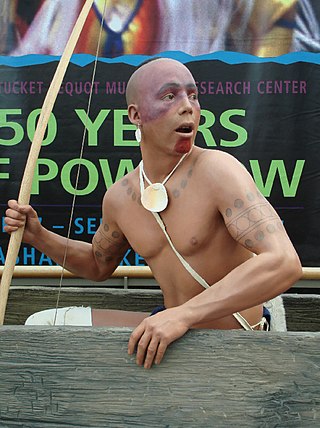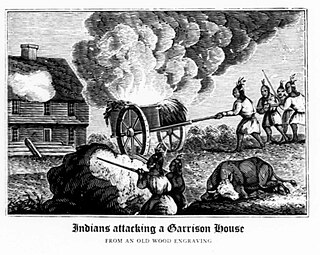
The Treaty of Hartford was a treaty concluded between English colonists in Connecticut, the Mohegan nation and the Narragansett nation on September 21, 1638, in Hartford, Connecticut.

The Treaty of Hartford was a treaty concluded between English colonists in Connecticut, the Mohegan nation and the Narragansett nation on September 21, 1638, in Hartford, Connecticut.
The Pequot War of 1636 and 1637 saw the virtual elimination of the Pequot Indians. The victors, English colonists living along the Connecticut River and their Mohegan and Narragansett allies, met to decide on the division of the fruits of victory.
The Mohegan and Narragansett tribes and the three English settlements in New England that would become the Connecticut River Colony in 1639, participated in the treaty. Surviving Pequot prisoners were divided between the tribes, with an unspecified number of captives being kept by the New England colonists; each tribe received 80 captives, with 20 captives being awarded to Ninigret, a sachem of the Eastern Niantic who were allied with the Narragansett. [2]
The Pequot lands went to the Connecticut River towns. The other major feature of this treaty was to outlaw the Pequot name. Any survivors would be referred to in the future as Mohegans or Narragansett. No Pequot town or settlement would be allowed. This treaty was signed on September 21, 1638. [3]
The Massachusetts Bay Colony, which had also participated in the anti-Pequot alliance, was not a party to the Treaty of Hartford. This led to a dispute between Massachusetts and Connecticut, with the Bay colony insisting that the Treaty of Hartford usurped its rights over Pequot lands under previous agreements with the Narragansetts and the Mohegans. [4]

The Pequot are a Native American people of Connecticut. The modern Pequot are members of the federally recognized Mashantucket Pequot Tribe, four other state-recognized groups in Connecticut including the Eastern Pequot Tribal Nation, or the Brothertown Indians of Wisconsin. They historically spoke Pequot, a dialect of the Mohegan-Pequot language, which became extinct by the early 20th century. Some tribal members are undertaking revival efforts.


Mystic is a village and census-designated place (CDP) in Groton and Stonington, Connecticut.

King Philip's War was an armed conflict in 1675–1676 between New England Native American peoples and New England colonists and their indigenous allies. The war is named for Metacom, the Pokanoket chief and sachem of the Wampanoag Confederacy who adopted the name Philip because of the friendly relations between his father Massasoit and the Mayflower Pilgrims. The war continued in the most northern reaches of New England until the signing of the Treaty of Casco Bay on April 12, 1678.
Uncasville is an area in the town of Montville, Connecticut, United States. It is a village in southeastern Montville, at the mouth of the Oxoboxo River where it flows into the Thames River. The name is now applied more generally to all of the east end of Montville, which is the area served by the Uncasville ZIP Code.

Miantonomoh, also spelled Miantonomo, Miantonomah or Miantonomi, was a chief of the Narragansett people of New England Indians.

Uncas was a sachem of the Mohegans who made the Mohegans the leading regional Indian tribe in lower Connecticut, through his alliance with the New England colonists against other Indian tribes.

The Pequot War was an armed conflict that took place in 1636 and ended in 1638 in New England, between the Pequot tribe and an alliance of the colonists from the Massachusetts Bay, Plymouth, and Saybrook colonies and their allies from the Narragansett and Mohegan tribes. The war concluded with the decisive defeat of the Pequot. At the end, about 700 Pequots had been killed or taken into captivity. Hundreds of prisoners were sold into slavery to colonists in Bermuda or the West Indies; other survivors were dispersed as captives to the victorious tribes.

The Narragansett people are an Algonquian American Indian tribe from Rhode Island. Today, Narragansett people are enrolled in the federally recognized Narragansett Indian Tribe. They gained federal recognition in 1983.

Roger Ludlow (1590–1664) was an English lawyer, magistrate, military officer, and colonist. He was active in the founding of the Colony of Connecticut, and helped draft laws for it and the nearby Massachusetts Bay Colony. Under his and John Mason's direction, Boston's first fortification, later known as Castle William and then Fort Independence was built on Castle Island in Boston harbor. Frequently at odds with his peers, he eventually also founded Fairfield and Norwalk before leaving New England entirely.

John Mason was an English-born settler, soldier, commander and Deputy Governor of the Connecticut Colony. Mason was best known for leading a group of Puritan settlers and Indian allies on a combined attack on a Pequot Fort in an event known as the Mystic Massacre. The destruction and loss of life he oversaw effectively ended the hegemony of the Pequot tribe in southeast Connecticut.

Ninigret was a sachem of the eastern Niantic Indian tribe in New England at the time of colonization, based in Rhode Island. In 1637, he allied with the colonists and the Narragansetts against the Pequot Indians.
Wyandanch (c. 1571 – 1659 was a sachem of the Montaukett Indians in the mid-17th century on eastern Long Island. Initially he was a minor chief among the Montaukett, but due to his skillful manipulation of various alliances and his accommodating stance towards the European colonists who gave him substantial military and economic support, he eventually became an influential "alliance chief" (a sachem who was responsible for maintaining friendly relations between his tribe and the settlers).

The Mystic massacre – also known as the Pequot massacre and the Battle of Mystic Fort – took place on May 26, 1637 during the Pequot War, when a force from Connecticut Colony under Captain John Mason and their Narragansett and Mohegan allies set fire to the Pequot Fort near the Mystic River. They shot anyone who tried to escape the wooden palisade fortress and killed most of the village. There were between 400 and 700 Pequots killed during the attack; the only Pequot survivors were warriors who were away in a raiding party with their sachem Sassacus.
The Mohegan are an Algonquian Native American tribe historically based in present-day Connecticut. Today the majority of the people are associated with the Mohegan Indian Tribe, a federally recognized tribe living on a reservation in the eastern upper Thames River valley of south-central Connecticut. It is one of two federally recognized tribes in the state, the other being the Mashantucket Pequot, whose reservation is in Ledyard, Connecticut. There are also three state-recognized tribes: the Schaghticoke, Paugusett, and Eastern Pequot.

The New England Colonies of British America included Connecticut Colony, the Colony of Rhode Island and Providence Plantations, Massachusetts Bay Colony, Plymouth Colony, and the Province of New Hampshire, as well as a few smaller short-lived colonies. The New England colonies were part of the Thirteen Colonies and eventually became five of the six states in New England, with Plymouth Colony absorbed into Massachusetts and Maine separating from it. Captain John Smith's 1616 work A Description of New England first applied the term "New England" to the coastal lands from Long Island Sound to Newfoundland.

The Pequot Fort was a fortified Native American village in what is now the Groton side of Mystic, Connecticut, United States. Located atop a ridge overlooking the Mystic River, it was a palisaded settlement of the Pequot tribe until its destruction by Puritan and Mohegan forces in the 1637 Mystic massacre during the Pequot War. The exact location of its archaeological remains is not certain, but it is commemorated by a small memorial at Pequot Avenue and Clift Street. The site previously included a statue of Major John Mason, who led the forces that destroyed the fort; it was removed in 1995 after protests by Pequot tribal members. The archaeological site was added to the National Register of Historic Places in 1990.

The Fairfield Swamp Fight was the last engagement of the Pequot War and marked defeat of the Pequot tribe in the war and the loss of their recognition as a political entity in the 17th century. The participants in the conflict were the Pequot and the English with their allied tribes. The Fairfield Swamp Fight occurred July 13–14, 1637 in what is present-day Fairfield, Connecticut. The town of Fairfield was founded after the battle in 1639.

Mohegan Indians v. Connecticut (1705–1773) was the first indigenous land rights litigation in history in a common law jurisdiction. James Youngblood Henderson, professor of law, calls the case "the first major legal test of indigenous tenure." Robert Clinton calls it the "first formal litigation of North American Indian rights."

The Mohegan Tribe is a federally recognized tribe and sovereign tribal nation of the Mohegan people. Their reservation is the Mohegan Indian Reservation, located on the Thames River in Uncasville, Connecticut.